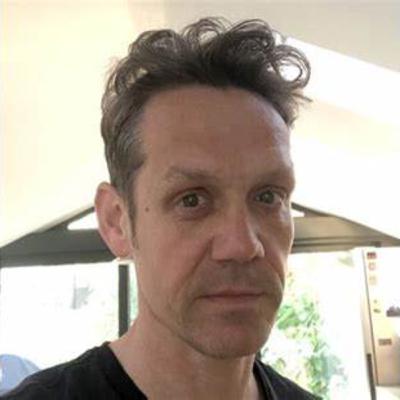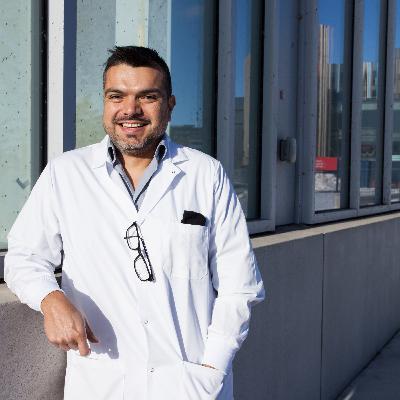Discover Brain Explained
Brain Explained

Brain Explained
Author: Abdullah Iqbal
Subscribed: 29Played: 204Subscribe
Share
© Abdullah Iqbal
Description
A podcast exploring fresh off the press neuroscience research. Tune in to our podcast for a deep dive interview exploring a research paper or thesis with the scientist themselves. Strengthen your understanding of the brain at the molecular level and gain an understanding of what it's like being a cutting-edge researcher.
Email - brainexplained@outlook.com.
LinkedIn - https://www.linkedin.com/company/brain-explained-podcast
Website - https://anchor.fm/abdullah-asad-iqbal
Support this podcast: https://podcasters.spotify.com/pod/show/brain-explained/support
Email - brainexplained@outlook.com.
LinkedIn - https://www.linkedin.com/company/brain-explained-podcast
Website - https://anchor.fm/abdullah-asad-iqbal
Support this podcast: https://podcasters.spotify.com/pod/show/brain-explained/support
23 Episodes
Reverse
Listen to learn about how dopamine neurons aren’t all the
same, some neurons use dopamine to reduce negative behaviours, to increase or
nothing at all. I’ll be talking to to Professor Danielle who loves everything to do with navigation
and Rajeshwar who is more of a dopamine specialist.
Links
Paper
Daniel.A.Domeck – lab
website
Rajesh Awatramani – lab
website
Daniel A Dombeck twitter
Brain fm - Music to improve focus, mood and sleep
Use the code – brainexplained to get 20%
Support the podcast using Brain Fm or through Patreon or Buy
Me a Coffee
Would love to hear from you, you can message through twitter, email or website .
I would love to hear about your research and I am always
looking for people to come o the podcast and editors.
---
Support this podcast: https://podcasters.spotify.com/pod/show/brain-explained/support
This was a brilliant episode as I have long been looking
into the research into a diagnostic test for Alzheimer’s Disease and dementia
in general. I for a long time for a paper on diagnostic markers for Alzheimer’s
Disease and demetnai in general because it is one of the roadblocks to help us
understand and eventually cure these diseases. We still cannot diagnose
Alzheimer’s Disease and most dementia’s until 15-20 years into the disease. And
this paper is a big step forward looking at over 5000 proteins in the blood. So
listen in to find out more.
NIA investigator page
https://irp.nih.gov/pi/keenan-walker
LinkedIn:
www.linkedin.com/in/keenan-walker-1268a6197
Paper:
https://www.ncbi.nlm.nih.gov/pubmed/37467317
---
Support this podcast: https://podcasters.spotify.com/pod/show/brain-explained/support
Today is a unique episode. It is the first time I will have
people interviewed on the show. I talked to both Professor Arne.D.Ekstrom and Sarah Seger who is a PhD student in his lab who did a lot of the work for the paper which is titled, ‘ Memory-related processing is the primary driver of human hippocampal theta oscillations.
Lab website
Paper
Twitter page
Podcast website
---
Support this podcast: https://podcasters.spotify.com/pod/show/brain-explained/support
This episode is a short one because I could not find the other episodes even after contacting Zoom.
We will be discussing the paper titled.
Non-invasive In Vivo Brain Astrogenesis and Astrogliosis Quantification Using a Far-red E2-Crimson Transgenic Reporter Mouse
---
Support this podcast: https://podcasters.spotify.com/pod/show/brain-explained/support
Today, I’ll be talking to Professor Scott Waddell and is research into memory in the Drosophila the commonly used fly in science research. Memory is one of the most interesting topics in the most interesting field which is neuroscience and this episode will not disappoint.
https://www.dpag.ox.ac.uk/team/scott-waddell
https://twitter.com/ScottishWaddell
---
Support this podcast: https://podcasters.spotify.com/pod/show/brain-explained/support
COVID may be something we do not want to think about but it is important that we carry on trying to understand the effects of this devastating virus. With Dr Daniel Martins de Souza we will be looking into the neural effects of COVID. Listen in to find out how it effects the brain.
Link to Paper
Link to Dr Daniel Martins de Souza
Link to Brain Explained Blog
---
Support this podcast: https://podcasters.spotify.com/pod/show/brain-explained/support
Microglia are the brain’s defense system and cleaning system and so are incredibly important for the normal functioning of the brain if you want to learn more about these fascinating cells then be sure to listen in to this episode of Brain Explained.
Dr David Menassa’s Twitter
Dr David Menassa’s lab page
The paper
---
Support this podcast: https://podcasters.spotify.com/pod/show/brain-explained/support
Come at listen to the latest episode of Brain Explained where we explore research looking into blood flow across the brain. A relatively new and very important area o research that is opening up so many findings.
The paper
Dr YongSoo lab website
Dr YongSoo’s Twitter
Brain Explained website
Brain Explained Twitter
---
Support this podcast: https://podcasters.spotify.com/pod/show/brain-explained/support
New neurons have been discovered that generate fever and illness in the brain. Want to learn more about them and how they where discovered then listen in to the latest podcast episode.
Dr Jessica Osterhout's Twitter
Dr Jessica Osterhout's University Profile
The Paper
Brain Explained Twitter
Brain Explained Website
---
Support this podcast: https://podcasters.spotify.com/pod/show/brain-explained/support
Want to learn about how genetic differences might affect your brain then come and listen to the most recent episode of Brain Explained where we explore just that. You’ll learn about the first-ever long-term study in this area and it does not disappoint. It is truly something to look forward to.
Laboratory Website
Paper
Brain Explained Twitter Account
---
Support this podcast: https://podcasters.spotify.com/pod/show/brain-explained/support
Episode Description
This episode is with Dr Titas is looking at retrograde zippering which is another way that neurons are able to correctly grow towards their correct final destination. What exactly does this system involve and how does this work? Listen in to learn all about it and we also explore why the C.elegans is a good model for neuroscience research- depending on the question you are asking.
I am also looking for individuals who would be interested in contributing to the blog. It would involve posts about the recent neuroscience that has been published preferably that week. You would try to explain the science in an easy to understand manner and would also want to delve into the significance of the findings. If this is something that interests you I would delighted to hear from you – please join the Brain Explained LinkedIn Contributors Page.
Linkto paper
Dr Titas Sengupta Twitter page
Link to website
---
Support this podcast: https://podcasters.spotify.com/pod/show/brain-explained/support
Listen in to learn more about arteriovenous malformations (AVM) a condition that leads to tangled blood vessels in the brain and spinal cord. This increases an individual’s likelihood of stroke. This week we will be exploring research that profiled the cells the blood vessels to find what changes occurred in these cells compared to normal samples. listen in to find out about this amazing research that could have wide-ranging implications.
Dr Ethan Winkler’s Twitter
Dr Ethan Winkler’s University Profile
The paper
---
Support this podcast: https://podcasters.spotify.com/pod/show/brain-explained/support
Episode 11 is all about dancing molecules and how they could be used to help improve spinal cord regeneration. Listen in to learn how proteins that move faster are more effective with Professor Samuel Stupps.
Link to paper - https://www.science.org/doi/10.1126/science.abh3602
Professor Stupp’s Lab Website - http://stupp.northwestern.edu/
Prof. Stupp's Twitter- https://twitter.com/SamuelStupp
Useful Links:
https://www.facebook.com/simpsonquerreyinstitute
https://twitter.com/sqinstitute
---
Support this podcast: https://podcasters.spotify.com/pod/show/brain-explained/support
Research looking into the effects of phones and concussions. An odd mix but interesting. Listen in to learn more. We’ll be talking to Dr Prasanna.
Link to dissertation work - https://digitalcommons.lsu.edu/gradschool_dissertations/5339/
---
Support this podcast: https://podcasters.spotify.com/pod/show/brain-explained/support
Episode Description
Come and listen to the first special episode. A conversation with Dr Argel who I meet through the Society of Neuroscience. We talk about his journey into neuroscience and his work covering memory and studies into neuroinflammation and ketamine.
Lab website
Twitter account
---
Support this podcast: https://podcasters.spotify.com/pod/show/brain-explained/support
Want to know how we work well in teams? Then listen in to the latest episode exploring team flow with Professor Mohammed Shehata. Flow is our ability to enter that state where everything aligns and we are able to focus entirely on the task at hand.
- The eNeuro paper (the journal article here)
News coverage including The Times Magazine London (here), Psychology Today (here and here), IFL Science (here), TVN (here), Science Alert (here), SciShow News (here), and more (here).
- Mohammad Shehata’s LinkedIn
- Mohammad Shehata’s Twitter :@Mohamma_Shehata
---
Support this podcast: https://podcasters.spotify.com/pod/show/brain-explained/support
I’m back on track. Here is the next episode. In this episode we explore dopamine signalling in the brain. Why? Because dopamine is the main signalling compound in your brain for reward. So eat a bar of chocolate, get a new job, pass your exams and you get a dose of dopamine. But the research by Professor David Kleinfield is even more important because it shows that mice can control their release of dopamine, which might explain why we can do things that to others seem strange such as climbing mountains. That isn’t all, listen in to learn about his other research around the role of the vasculature in the brain and how senses work.
David Kleinfield lab website
The main paper
Two other interesting papers (which can be found on his website):
Ultra-slow oscillations in fMRI and resting-state connectivity: Neuronal and vascular contributions and technical confounds.
Brain microvasculature has a common topology with local differences in geometry that match metabolic load.
---
Support this podcast: https://podcasters.spotify.com/pod/show/brain-explained/support
Episode 6 will be looking at the brain regions involved in spirituality and Religiosity which is another word for religion. Therefore, I am extremely grateful to give you this unique episode. This episode will be of interest as over 90% of percent of people have some sort of spiritual practice and the other 10% will want to know how the brain is linked to spirituality and religion and what it means. Not only is this research interesting but it can help people make electrical stimulation therapy which is becoming even more common to reach the forefront.
Neurospirituality course syllabus:
https://neuromichael.com/neurospirituality-course/
Twitter for Professor Michael Ferguson:
https://twitter.com/neuromichael/status/1433525429227372545
Biological Psychiatry article access:
https://www.sciencedirect.com/science/article/pii/S0006322321014037?dgcid=author
Neuromichael YouTube channel:
https://www.youtube.com/neuromichael
---
Support this podcast: https://podcasters.spotify.com/pod/show/brain-explained/support
Episode 5 dives traumatic brain injury a disease commonly received after too many blows to the head. How can we protect against this and how exactly is it studied in the lab. If that piques your interest then be sure to check out for we cover this and much more with Dr Andrew Pieper, a researcher in this field from the Harrington Discovery Institute.
Link to Dr Andrew Pieper’s Lab Website
Link to Dr Andrew Pieper’s LinkedIn
Link to paper
Brain Explained - Twitter
Brain Explained - LinkedIn
---
Support this podcast: https://podcasters.spotify.com/pod/show/brain-explained/support
Episode 4 of Brain Explained explores a new theory for understanding pain. Pain, its something we feel often and that many people chronically suffer from with an estimated 40% of people suffering from chronic pain and understanding pain would allow us to help them. That is where Dr Franziska Denk’s Research comes into play. For she is describing a new theory showing that a type of cell called a fibroblasts may be the key player in chronic pain. Listen to the episode to find out how.
Link to Franziska Denk’s lab website
Link to Twitter page for lab
Link to LinkedIn
Links to papers:
Fibroblasts– the neglected cell type in peripheral sensitization and chronic pain? - A systematic view on the current state of the literature.
A transcriptional toolbox for exploring peripheral neuro-immune interactions
Sensitization of Knee-Innervating Sensory Neurons by Tumour Necrosis Factor-α Activated Fibroblast-Like Synoviocytes: An in Vitro, Co-Culture Model of Inflammatory Pain.
Resources:
https://www.coursera.org/learn/statistical-inferences
https://www.franziskadenk.com/resources
https://rna-seq-browser.herokuapp.com/
https://rna-seq-browser.herokuapp.com/
http://mousebrain.org/genesearch.html
https://panglaodb.se/
---
Support this podcast: https://podcasters.spotify.com/pod/show/brain-explained/support

























